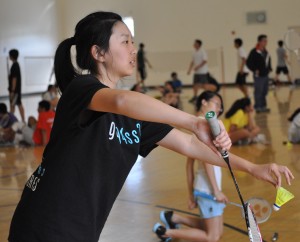As a birdie soars through the air, a Monta Vista badminton player scrambles toward the net and prepares to perform a long-practiced powershot. She misses. Instantly, badminton
head coach Charley Situ’s voice echoes over the field house walls. “Hey! Faster next time. Don’t just stand there like a Charley’s Dummy.”

‘Charley’s Dummies,’ an affectionate nickname for the badminton team which was inspired by the television series ‘Charlie’s Angels,’ reveals the chirpy side of the coach that has pushed players to CSS finals nine out of the last 10 years, in multiple divisions. In addition, several team players are nationally ranked — one member, sophomore Justin Ma, has won the Pan Am Junior Badminton tournament, marking him the best singles player in the Americas for his age group.
Yet, given this wealth of accomplishments and dedicated athletes, the team surprisingly manages to stay out of the school spotlight.
“I think people view badminton as sort of a joke and that anyone who can hit a birdie can get on the team. But you really do have to be good to make the team,” varsity player junior Anu Vaishnav said. And you do have to be good — MVHS badminton team is a prominent, accomplished team, with a dominant reputation and multiple CCS championships.
The badminton team’s success can be largely attributed to the motivation of the players themselves. Although school practices run every weekday for two to three hours during the spring season, many team players train year round at prestigious clubs such as Bing Tang Badminton Academy, where they participate in regional and national tournaments.
“There are lots of coaches, it’s really competitive, and there are tournaments all over the place. It’s much more serious than high school badminton,” senior Ryan Ke said.
Other team players, like senior Erika Sporkert and her sister, freshman Madeline Sporkert, have been playing the sport since they were young children.
“My mom’s from Malaysia, so she used to play a lot of badminton when she was younger. When my sister and I were little, we all used to play on the driveway together. My mom was really good. I looked up to her for that,” said Erika.
Many students claim the success of the team is due not only to players’ individual passion, but also to the coaching of Situ. “He’s a really tough coach, and he always pushes us to do better,” said junior Melissa Wang.
Given their devotion to practice, the team has a strong sense of community. Outside of practice time, players meet at events such as ‘Baddy Buddies,’ where team members exchange gifts anonymously. The goal of these events is to foster a sense of closeness within the team and to forge friendly bonds between players. Because badminton is a sport where players can feel isolated from one another as they play individual games on the court, this sense of friendliness is a crucial aspect of the team’s success, since it reinforces the impression that the players are unified as a team within a school.
Like the majority of high school sports, the team is divided into varsity and junior varsity levels, with each group broken into single and doubles counterparts. Inside of this structure, badminton members are made to constantly compete for higher spots — or to even keep one at all.
Each week, players participate in a series of inter team matches to determine their position for that passing week. While badminton sports over a 60-player roster, only around 45 spots are needed per game. This fluid change of ranking pushes players to remain competitive at all times, or to risk being bumped down to a lower position.
The tight-knit community of the team is sometimes challenged by this extreme competition between its players. Ke explains that arguments between members do occur, if only rarely. Passion for the sport, coupled with the amount of talent on the team and the hours spent practicing, can cause tension between teammates.
Despite this, the team guarantees that the competitive spirit in their relationships with each other is healthy, and allows each player to polish their skills throughout the season.
“In the end, the competitiveness brings us closer together. It drives us to improve, rather than driving us apart,” said Erika Sporkert. “It’s a different type of bonding.”





